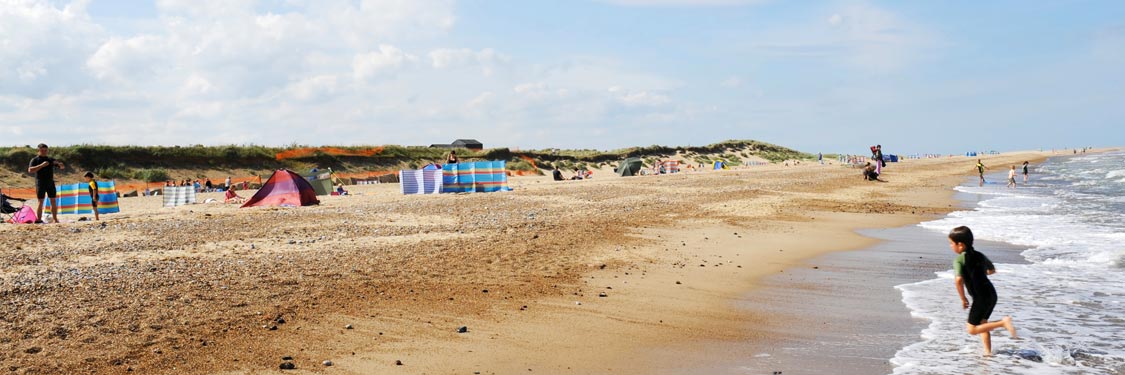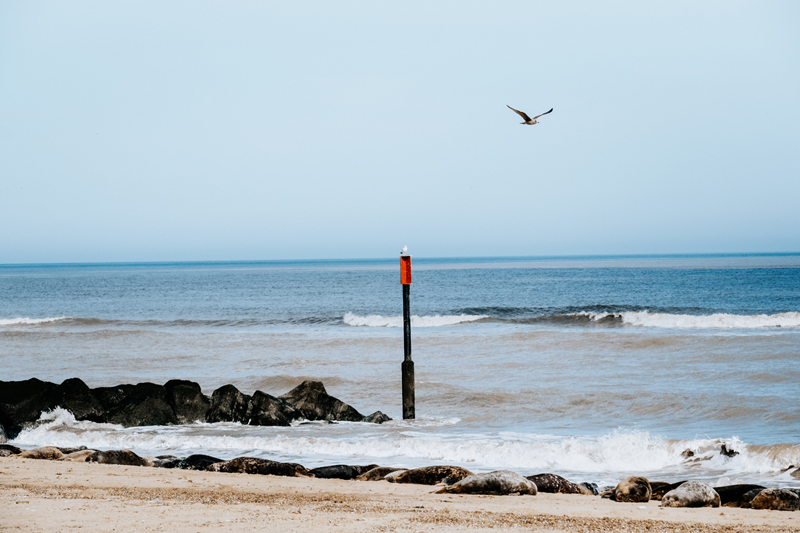

Do your family like to be beside the seaside? If so, you’ve come to the right place. As home to many of the country’s top resorts you’ll be spoilt for choice when deciding where to build your sandcastle along the Norfolk and Suffolk coast.The Broads is lucky to not only claim 200km of inland waterways but is also on the doorstep of some of the country’s most enchanting coastline boasting 2.7km within the park boundary, while a few miles further takes you to the striking North Norfolk coast or further south to the Sunrise Coast of Suffolk.
From the bright lights of Great Yarmouth, to the quaint fishing villages that dot the coastline, you’re sure to find something to please everybody. With its iconic beach huts and Victorian pier – complete with Tim Hunkin’s weird and wonderful take on the amusement arcade – a visit to nearby Southwold should also be on your itinerary.

Beautiful Horsey is a must, especially in winter with its large colony of seals. You can view the seals from November to January when around 100 pups are born. The village is only a mile from the coast accessible by footpath over a sand dune nature reserve and the beach itself offers wonderful walks.
Part of the unspoilt natural sandy stretch of the east Norfolk coast and just 10 minutes from the Broads market town of Stalham,Sea Palling is renowned for windsurfing and Waxham for two large campsites right next to marron-grassed dunes. Water sports ranging from swimming to jet skiing are also a part of Sea Palling life. The village boasts two pubs with restaurants, a general store, beachside amusement arcade, cafes, caravan parks and launching facilities for pleasure craft. Waxham has a rural beach, where seals can be seen close in-shore and later in the season with their pups on the beach. Waxham village is also home to one of the largest tithe barns in the country, built in the 16th century, where you can get refreshments in a historical setting.
Sea Palling is on the Sanders Coaches route number 34 (Monday to Friday), stopping at North Walsham, Hickling and Stalham amongst other towns/villages. Waxham is a short walk from Sea Palling.
The traditional kiss-me-quick seaside resort of Great Yarmouth is also within the park boundary with its sandy beaches, amusement arcades, family-friendly Pleasure Beach fairground and great seafood restaurants. Central beach sits between the grand Wellington and Britannia piers which are themselves flanked by South and North beaches.
You can get the train to Great Yarmouth from Norwich, Brundall and Acle with Greater Anglia.
Undisturbed, soft carpets of golden sand back onto the hilly, grassy dunes of Winterton-on-sea. One of East Norfolk’s favourite coastlines, like many others in the region, it’s maintained and protected by the National Nature Reserve because of its areas of Specific Scientific Interest (SSI). Behind the main body of the beach, an extensive system of wild, barren dunes, home to the rare natterjack toad, meet shrubby heaths, birch woodland and flourishing marshlands that stretch all the way over to Horsey.
There is no train station at Winterton but you can get the Coastal Clipper bus from Great Yarmouth, Hemsby and the many of the villages nearby villages in the area.
Hemsby Beach, near Great Yarmouth is a lively village resort with shops, amusements, attractions and cafes. The stunning golden, wide sandy beach with its grassy sand dunes makes this a popular choice with visitors.
Hemsby is also accessible via the Coastal Clipper bus from Great Yarmouth and other villages.
Famous for being the most easterly town in the UK and the first place to see the sun rise, Victorian Lowestoft is also the birthplace of composer Benjamin Britten. The town is a favourite with families, and there's plenty to see and do; with two piers, a zoo, an award-winning theme park, museums and the thriving Marina Theatre which boasts the Royal Philharmonic as its resident orchestra.
Lowestoft is accessible by both train with Greater Anglia (from Norwich and Ipswich) and the Coastal Clipper bus.
Just a few miles from the edge of the Broads is Cromer with its well-derserved nickname, the ‘Gem of the Norfolk coast’. Winding streets filled with delightful independent retailers and restaurants, lead to a seafront that combines contemporary design with traditional British seaside charm. Visit the fascinating Henry Blogg Museum – celebrating the most decorated lifeboatman in RNLI history – or take a stroll along the Victorian pier. And don’t forget to sample some famous Cromer crab while you’re in town.
A famous landmark in Norfolk, the historic Pier at Cromer beach is an important example of the county’s history. Situated on the exact same spot as the first jetty erected in Cromer in 1391, the pier stands proud to this day. Take a few minutes to pause and read the fascinating potted history of this historic structure on the posters at the entrance. And eat your fish and chips with the best view around. Not only the perfect spot for promenading, the pier hosts a variety of traditional shows, a gift shop and restaurant (with a sea view of course), to tempt visitors of all age groups, so that your trip to this beautiful coastal town’s beach can end on a high.
Just along the coast, Sheringham is slightly smaller, but just as packed with exciting things to see and do. The town is a magnet for railway enthusiasts, with regular steam trains running along the Poppy Line to Holt. Hop on and off at the beautifully preserved stations along the route, or enjoy a delicious meal on the dining train. Every year, Sheringham and Cromer join forces to celebrate their rich fishing heritage with the Crab and Lobster Festival – a weekend-long celebration of food, music, art and history. If you’re visiting in May, you won’t want to miss it.
Southwold, which sits near to the Broads nestled on Suffolk’s Heritage Coast, is a charming seaside town with many interesting things to see and do. Stroll along the Victorian pier, take in the iconic beach huts lining the seafront promenade, or tour the fully-functioning lighthouse that rises up from the heart of the town.
As home to the world famous Adnams Brewery, you won’t need to go far to find tempting things to eat and drink while you’re in town. You can even take a tour of the brewery or distillery and have a go at making your own gin.
Between the vast expanse of salt marshes at Stiffkey and the soft golden sands at Holkham beach, lies the coastal town of Wells-next-the-sea. The historic port at Wells is overlooked by an impressive early 20th century granary, now converted into luxury flats, with its original gantry still in place, suspended above the seaside path. The beach itself, a sublime stretch of sand, dotted with traditional, candy coloured wooden beach huts, backs onto beautiful, grassy dunes and an imposing strip of pine tree forest. Wells, like many other spots on the North Norfolk coastline, is considered an Area of Outstanding Natural Beauty (AONB).
Thick blankets of golden sand stretch for miles on the North Norfolk coastline at Brancaster. Towards the east, as the beach curves off, sweeping into the estuary, the historic harbour can be found. A busy port until the 1800s, cargo ships loaded with coal and grain dotted the skyline until trade declined – now only the town’s thriving fishing community and pleasure crafts remain. Grassy banks and muddy creeks are home to the scattered fishing nets and boats you’ll spot, as you make your way through the harbour. And the maze of wetlands flood with rivulets, too small for any ships to pass through their waters. On the beach, an old shipwreck, now engulfed by the sands, can be seen and reached when the tide is out.
A historically thriving commercial port, Blakeney Point used to be filled with passing cargo vessels coming in and out of the country for trade. Silting over time on the main estuary made it impossible for large ships to leave the harbour, meaning it’s now only used for sailing and pleasure craft. Natural silting has left behind an expanse of captivating landscapes, filling the once-busy trade area with boggy salt marshes, sand and shingle spits, windswept grassy dunes and a labyrinth of creeks twisting through the grassland. As well as its amazing spectrum of landscapes, Blakeney is now known for its wildlife, including its famous breeding ground for seals. The imposing blue lifeboat house stands out from the vast earthy terrain at Blakeney Point and marks the National Trust’s Nature Reserve for the area. A boardwalk from there, leads to the sweeping sand and grey pebble beaches.
A bumpy path from the picturesque coastal village is the best way to get to the beach at Stiffkey, pronounced 'stookey'. From there, meandering estuaries course through the marshlands from the sea, creating twisting muddy creeks that flood daily, making perfect habitats for all sorts of wildlife, with a series of rickety, wooden bridges in place to help you cross. Those who manage to navigate the marsh will be greeted by breathtakingly beautiful secluded lagoons, that stretch onto the area of sandy banks leading to the waters.
Sat under the shadow of Southwold, one of Suffolk’s main tourist destinations, lies the quaint and lesser-known coastal village of Walberswick. A perfect retreat from the hustle and bustle of city life, it boasts serene, shallow waters, beautifully kept sand and shingle beaches and a community of wooden holiday huts, available to rent in the summer months. Further down south, low, soft and sandy cliffs crumble onto the shore where the landscape is less even. Behind the beach, swirling sand dunes, salt marshes and saline lagoons, as well as grass and woodlands, are protected by the National Nature Reserve. One of the most diverse sites in the UK for its landscape and wildlife, many unique, internationally important animals now call Walberswick their home.
Norfolk has 90 miles of coast, much of it pristine unspoilt sandy beaches in or embracing the Broads
Look up a range of days out in the Broads in our listings
Check out our pick of days out on the coast